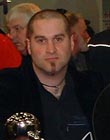|
|
 
|
|
Author
|
Topic: Vic 5 at Silent Speed
|
|
|
|
|
|
|
|
|
|
|
|
|
|
|
William Hooper
Phenomenal Film Handler
Posts: 1879
From: Mobile, AL USA
Registered: Jun 99
|
 posted 07-16-2001 01:43 AM
posted 07-16-2001 01:43 AM





Be aware that "Silent Speed" varied from 16 fps for the early Griffith Biographs to 24 or more fps for some later silents.David Pierce has information about silent film speeds at http://www.cinemaweb.com/silentfilm/bookshelf/#March1998 Make sure that you've got a pot on the motor control, not a multiposition switch. Believe it or not, for a lot of the late silents, especially comedies, 24 fps will be correct. SMPE came up with the standard of 24 fps for sound speed by doing a survey of the speeds that most houses were running their films at - yep, 24. But those Griffith Biographs & other early silents will sho nuff look wrong at that speed.
| IP: Logged
|
|
|
|
|
|
|
|
Leo Enticknap
Film God

Posts: 7474
From: Loma Linda, CA
Registered: Jul 2000
|
 posted 07-19-2001 02:35 AM
posted 07-19-2001 02:35 AM





If the V5 in question has a turret, you don't even need eccentrically mounted lens sleeves - it's possible to offset the lens for the optical centre of the 'full gate' frame using the adjustment screws.I've run silents on V5s a fair bit (at speeds as low as 16fps) and have never had a problem with the governor switches. The light loss from the three-blade shutter, IMHO, is a much bigger problem. Bear in mind that tinted and toned prints absorb even more light than black-and-white ones. Assuming that your lamp output is speced to 16ft-l with a two-blade shutter, I reckon (though I've never had a meter to actually check this) with a three-bladed shutter at 16 with a tinted print, it could go as low as 9-10. So if this setup is going to run silents regularly, I'd suggest installing a lamp of sufficient brightness to give 16ft-l with a three-bladed shutter, and leaving it (the shutter) installed permanently, regardless of the running speed. Incidentally, an excellent article on silent film projection speeds by Kevin Brownlow can be found in 'Sight & Sound', vol. 49, no. 3 (Summer 1980), pp. 164-167.
| IP: Logged
|
|
John Pytlak
Film God

Posts: 9987
From: Rochester, NY 14650-1922
Registered: Jan 2000
|
 posted 07-19-2001 07:24 AM
posted 07-19-2001 07:24 AM





Leo said: "The light loss from the three-blade shutter, IMHO, is a much bigger problem. Bear in mind that tinted and
toned prints absorb even more light than black-and-white ones. Assuming that your lamp output is speced to
16ft-l with a two-blade shutter, I reckon (though I've never had a meter to actually check this) with a
three-bladed shutter at 16 with a tinted print, it could go as low as 9-10. So if this setup is going to run silents
regularly, I'd suggest installing a lamp of sufficient brightness to give 16ft-l with a three-bladed shutter."Assuming the same image size, you will typically need twice the lamp power if you replace a two-blade shutter with a three-blade shutter. IMHO, shutter flicker is intolerable for a two-blade shutter at less than 20 fps. At 24fps, shutter flicker is imperceptable with a three-blade shutter, even at very high screen luminance. But since you will be usually be using the full frame for silents, you should have more light available than a "cropped" format like 1.85:1 flat, where much of the light is lost at the aperture plate. ------------------
John P. Pytlak, Senior Technical Specialist
Worldwide Technical Services, Entertainment Imaging
Eastman Kodak Company
Research Labs, Building 69, Room 7419
Rochester, New York, 14650-1922 USA
Tel: 716-477-5325 Cell: 716-781-4036 Fax: 716-722-7243
E-Mail: john.pytlak@kodak.com
Web site: http://www.kodak.com/go/motion
| IP: Logged
|
|
|
|
|
|
|
|
All times are Central (GMT -6:00)
|
|
Powered by Infopop Corporation
UBB.classicTM
6.3.1.2
The Film-Tech Forums are designed for various members related to the cinema industry to express their opinions, viewpoints and testimonials on various products, services and events based upon speculation, personal knowledge and factual information through use, therefore all views represented here allow no liability upon the publishers of this web site and the owners of said views assume no liability for any ill will resulting from these postings. The posts made here are for educational as well as entertainment purposes and as such anyone viewing this portion of the website must accept these views as statements of the author of that opinion
and agrees to release the authors from any and all liability.
|

 Home
Home
 Products
Products
 Store
Store
 Forum
Forum
 Warehouse
Warehouse
 Contact Us
Contact Us




 Printer-friendly view of this topic
Printer-friendly view of this topic

















